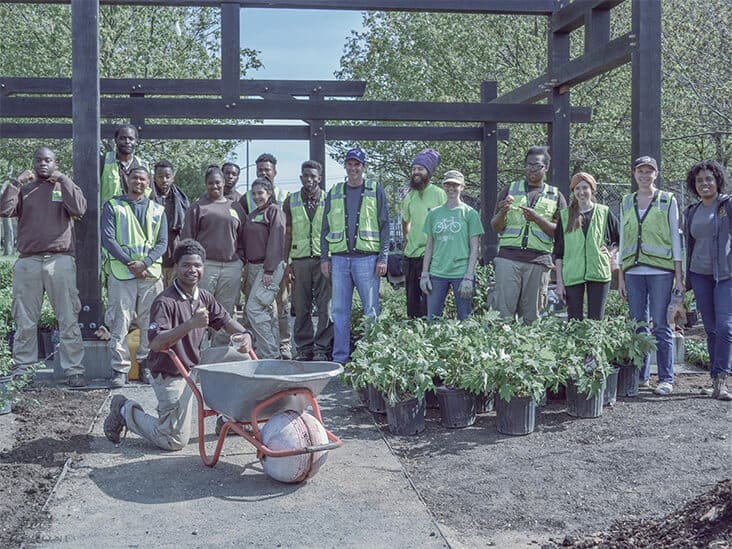In a recent blog post, we explored the concept of community wellness. In this post, we explore community building, which is the activities that bolster community wellness.
Here at Ecotone, our basic mantra is to “Dream. Unite. Build.” First, we visualize the community in which we want to live. Then, we unite with our neighbors and their dreams. And lastly, we build – together.
Tangibly, this means that community building happens on two levels. The first is the social level, meaning that we seek to build community through building social structures. And secondly, true to our love of carpentry and public works projects, we believe that community building also involves building physical infrastructure that provides goods and services to the community.
Let’s explore these two concepts more in-depth, as well as the way Ecotone is building community right here in Brooklyn.
Building Social Structures
Community building starts with creating a network of genuine, meaningful relationships within the local community. The National Wellness Institute highlights social wellness as a key component of holistic wellness. So, by building relationships in our physical communities, we support community wellness. Similarly, according to the National Institutes of Health, positive relationships can help support mental and physical health, meaning that social connectedness can even improve individual wellness.
So, how can we go about building these social structures?
A social network starts at a micro-level as you develop meaningful relationships with a few people in your local community.
Then, that network can extend to building bridges with people on your block through grassroots organizing efforts, such as inviting people to events through social media platforms.
From there, the web of connections can continue to extend out across the neighborhood. As you build relationships with local businesses, faith-based groups, non-profit organizations, and so on, you create friendships and relationships that build an interconnected, meaningful community.
As we get to know our neighbors, we also gain a better understanding of the history and culture of our communities, which equips us to meet our neighbors’ needs and make sure that we can all pursue wellness together.
Building Physical Infrastructure
In addition to building social networks, community building also involves building physical infrastructure that supports people in the community.
In the U.S., the building of physical infrastructure typically occurs on government levels. However, especially in urban contexts, cities and mayors often times are unable to keep up with the needs of each community. This phenomenon can lead to the privatization of public goods, which limits community access to goods and resources, especially for people who are already more economically burdened. In other words, privatization increases inequality and compounds problems for the poor.
So, how can community building counteract this phenomenon?
Each community contains the physical and human resources needed to create ground-up solutions to its needs. In fact, the people in the community are the ones who know and understand the needs and strengths of the community best, thus making them more capable of finding real solutions to community challenges. Here at Ecotone, we believe in empowering people to build their own communities through public works projects and apprenticeship programs.
Ecotone and Community Building
In 2010, Ecotone’s founder Craig Desmond launched Ecotone Building. To fulfill Ecotone’s mission of community building, Desmond facilitates apprenticeship programs with young people in the community.
“I started Ecotone Building to meet some of the unmet building needs of the community. My idea was to train some young people from inside the community to have the skills to take matters into their own hands, to have their own ideas, and to design and build the communities that they want to live in.” – Craig Desmond, Brooklyn 2014.
Since the program’s inception, Desmond has partnered with workforce development non-profits from The Doe Fund to Green City Force and executed projects in community gardens and in NYCHA developments. Ecotone has organized and managed volunteer community building events with dozens of apprentices and hundreds of volunteers and has run formal apprentice trainings with a variety of formats, durations, and depths. Over the years, Desmond has learned some of what works, and some of what does not. He has learned not only how to share skills, but also how to inspire confidence and passion in young people.
Upon completing a shed building project using all salvaged materials, one apprentice remarked “The amount of effort and work that you put in, the amount of time and energy that you put in, is conducive to the product that you have at the end of it. And that’s one of the best lessons I learned here.”
Furthermore, the apprentices learn about the big picture of community building and become inspired to contribute to their own communities in ways that will help build human connections.
At the end of the program, one apprentice commented, “I would love to be able to playgrounds. You know, places people can go and get together and really connect with each other.”
To learn more about this program and to hear from past participants, check out this video.
While Ecotone has already done a lot of work in the community on smaller projects, our ultimate vision is to build a trade school in conjunction with a formal guild of small businesses specialized in skilled trades, design, and the arts. The Ecotone vision is to create a facility that is an economic engine and a powerful learning platform designed for apprentice training.
Have an idea for community project?
Feel free to send us a message about potential collaborations!




